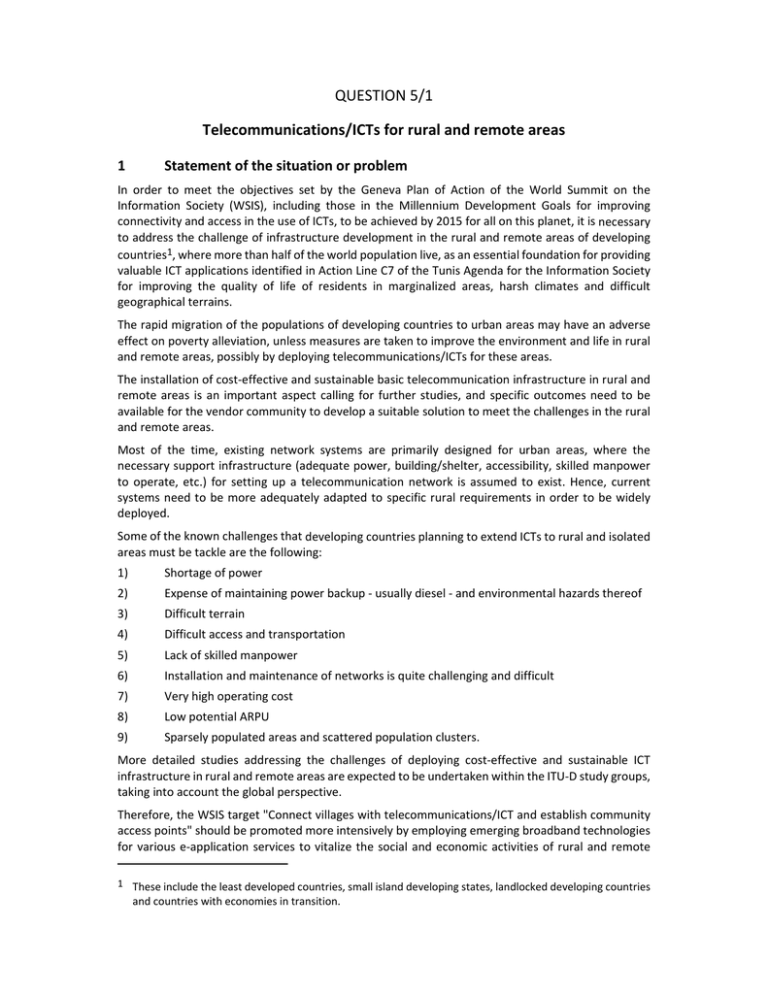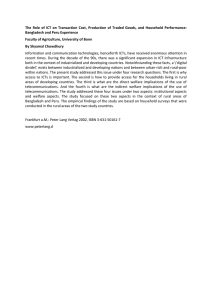QUESTION 5/1 Telecommunications/ICTs for rural and remote areas 1 Statement of the situation or problem
advertisement

QUESTION 5/1 Telecommunications/ICTs for rural and remote areas 1 Statement of the situation or problem In order to meet the objectives set by the Geneva Plan of Action of the World Summit on the Information Society (WSIS), including those in the Millennium Development Goals for improving connectivity and access in the use of ICTs, to be achieved by 2015 for all on this planet, it is necessary to address the challenge of infrastructure development in the rural and remote areas of developing countries1, where more than half of the world population live, as an essential foundation for providing valuable ICT applications identified in Action Line C7 of the Tunis Agenda for the Information Society for improving the quality of life of residents in marginalized areas, harsh climates and difficult geographical terrains. The rapid migration of the populations of developing countries to urban areas may have an adverse effect on poverty alleviation, unless measures are taken to improve the environment and life in rural and remote areas, possibly by deploying telecommunications/ICTs for these areas. The installation of cost‐effective and sustainable basic telecommunication infrastructure in rural and remote areas is an important aspect calling for further studies, and specific outcomes need to be available for the vendor community to develop a suitable solution to meet the challenges in the rural and remote areas. Most of the time, existing network systems are primarily designed for urban areas, where the necessary support infrastructure (adequate power, building/shelter, accessibility, skilled manpower to operate, etc.) for setting up a telecommunication network is assumed to exist. Hence, current systems need to be more adequately adapted to specific rural requirements in order to be widely deployed. Some of the known challenges that developing countries planning to extend ICTs to rural and isolated areas must be tackle are the following: 1) Shortage of power 2) Expense of maintaining power backup ‐ usually diesel ‐ and environmental hazards thereof 3) Difficult terrain 4) Difficult access and transportation 5) Lack of skilled manpower 6) Installation and maintenance of networks is quite challenging and difficult 7) Very high operating cost 8) Low potential ARPU 9) Sparsely populated areas and scattered population clusters. More detailed studies addressing the challenges of deploying cost‐effective and sustainable ICT infrastructure in rural and remote areas are expected to be undertaken within the ITU‐D study groups, taking into account the global perspective. Therefore, the WSIS target "Connect villages with telecommunications/ICT and establish community access points" should be promoted more intensively by employing emerging broadband technologies for various e‐application services to vitalize the social and economic activities of rural and remote 1 These include the least developed countries, small island developing states, landlocked developing countries and countries with economies in transition. areas. Multipurpose community telecasters (MET), public call offices (PCO), community access centres (CAC) and e‐posts are still valid in terms of cost effectiveness for sharing infrastructure and facilities by community residents, leading to the goal of provision of individual telecommunication access. Therefore, it is proposed to deal with the challenges and system requirements of fixed and mobile networks for rural deployments in developing nations. Decisions that may drive first the examination and then the choice of particular techniques and solutions for the provision of multimedia telecommunications/ICT services may be influenced by, inter alia, the following: a) Increasing availability of telecommunications/ICTs that provide enhanced broadband connectivity at progressively lower costs, lower energy consumption and lower greenhouse gas emissions. b) Experience gained since the previous ITU‐D study cycles in many parts of the world in developing, implementing and refining major rural telecommunication programmes, as more countries respond to particular situations, and in‐country demand using "best practices" as outlined in the work of ITU‐D. c) The influence of cultural, social and other factors in producing differing and often creative responses to meeting the demand for multimedia services from residents of rural and remote areas of developing and least developed countries. d) Progress being steadily made on human resources development/management issues which are fundamental to establishing sustainable telecommunication infrastructure. 2 Question or issue for study There are a variety of several (new and old) issues that members will be interested in addressing within the four coming years of this Question. It is proposed that the main issue for study continue to be the range and scope of techniques and solutions that are expected to play a significant role in the provision of e‐application services for rural and remote areas, with particular attention to the provision of broadband access through sustainable networks including interoperable International Mobile Telecommunications (IMT) in suitable frequency bands, such as 450‐470 MHz and other frequency bands identified for IMT. It is further proposed that the study should progress in stages, to cover a four‐year cycle in the following manner: – Step 1: Continue identification of the full range of potential techniques and sustainable solutions that can significantly impact on the provision of telecommunication/ICT applications in rural and remote areas, with emphasis on those that employ the latest broadband technologies designed to lower infrastructure capital and operating costs, assisting convergence between services and applications, taking into considerations reducing greenhouse gas emissions. – Step 2: Continue to investigate and report on how the techniques identified above can be used to best deliver the range of services and applications required by rural and remote communities and adapted to the needs of their users. – Step 3: Identify, assess and consolidate the challenges faced by developing countries in setting up or upgrading telecommunication infrastructure in rural areas, including those aimed at providing enhanced broadband connectivity through networks based on suitable interoperable IMT frequency bands, such as 450‐470 MHz and other frequency bands identified for IMT. – Step 4: Report on the public policies and regulatory measures carried out by developing countries to overcome or mitigate the above‐mentioned challenges. – Step 5: Describe the evolution of system requirements for rural network systems specifically addressing such identified challenges of rural deployment. – Step 6: Continue consideration of the quality of the services provided, and the cost effectiveness, degree of suitability in different geographies and sustainability of the techniques and solutions identified in the above‐mentioned steps. – Step 7: Augment the report on the set of case studies that clearly demonstrate how a range of techniques, based on new technology aimed at providing reduced capital and operating cost solutions, reducing GHG emissions and enhancing community participation, can maximize the benefits of broadband telecommunication/ICT infrastructure in rural and remote areas. – Step 8: Identify business models for sustainable deployment of networks and services in rural and remote areas, taking into consideration priorities based on economic and social indicators. During the study carried out in each of the steps, the following matters should also be studied and reflected in the outputs of the Question: – environmental sustainability in deploying the infrastructure and necessary robustness of telecom infrastructure; – maintenance and operational aspects to provide a quality and continuous service; – demand‐side factors and practices to generate and increase the usage of ICT devices and services; – efforts to build ICT skill sets for the deployment of broadband services; – relevant localization of content; – affordability of services/devices for rural users to adopt so as to fulfil their development needs. In dealing with the above studies, the work under way in response to other Questions being dealt with in ITU‐D, and close coordination with relevant activities under those Questions, in particular Questions 1/1, 2/1, 4/1 and Questions 2/2, 4/2 and 5/2, are highly relevant. In the same way, the studies shall take into account cases related to indigenous communities, isolated and poorly served areas, least developed countries (LDCs), small island developing states (SIDS) and landlocked developing countries (LLDCs), and highlight their particular needs and other particular situations which need to be considered in developing telecommunication/ICT facilities for these areas. 3 Expected output The output will be a report on the results of the work conducted for each step above, together with one or more recommendations at appropriate times, either during the course of or at the conclusion of the cycle. 4 Timing The output will be generated on a yearly basis. The output from the first year will be analysed and assessed in order to update the work plan for the next year, and so on. 5 Proposers/sponsors The Question was originally approved by WTDC‐94, and subsequently revised by WTDC‐98, WTDC‐02, WTDC‐06, WTDC‐10 and WTDC‐14. Brazil, India and Japan. 6 Sources of input Contributions are expected from Member States, Sector Members and Associates, as well as inputs from relevant BDT programmes, particularly those that have successfully implemented telecommunication/ICT projects in rural and remote areas. These contributions will enable those responsible for work on this Question to develop the most appropriate conclusions, recommendations and outputs. The intensive use of correspondence and online exchange of information and experiences is encouraged for additional sources of inputs. 7 Target audience Developed countries Developing countries1 Relevant policy‐makers Yes Yes Telecom regulators Yes Yes Rural authorities Yes Yes Service providers/operators Yes Yes Manufacturers, including software developers Yes Yes Vendors Yes Yes Target audience a) Target audience Depending on the nature of the output, upper‐ to middle‐level managers in operators and regulators in developing countries, including relevant rural authorities, are the predominant users of the output. The study outcomes will ensure adequate attention of vendors to focus on their development efforts to meet the needs of developing countries. b) Proposed methods for implementation of the results To be decided during the study period. 8 Proposed methods of handling the Question Within Study Group 1. 9 Coordination The ITU‐D study group dealing with this Question will need to coordinate with: – Focal points of the relevant Questions in BDT – Coordinators of relevant project and programme activities in BDT – Regional and scientific organizations with mandates covering the subject matter of the Question – Other relevant stakeholders (see Recommendation ITU‐D 20). As may become apparent within the life of this Question. 1 These include the least developed countries, small island developing states, landlocked developing countries and countries with economies in transition. 10 BDT programme link WTDC Resolution 11 (Rev. Dubai, 2014), Resolution 68 (Rev. Dubai, 2014) and Recommendation ITU‐ D 19. Links to BDT programmes aimed at fostering the development of telecommunication/ICT networks as well as relevant applications and services, including bridging the standardization gap. 11 Other relevant information As may become apparent within the life of this Question.



